Mark Blundell: The Motor Sport interview
Four seasons in Formula 1, seven Le Mans appearances, a crack at CART and a sunset season in BTCC. Mark Blundell recalls his proudest moments and missed opportunities
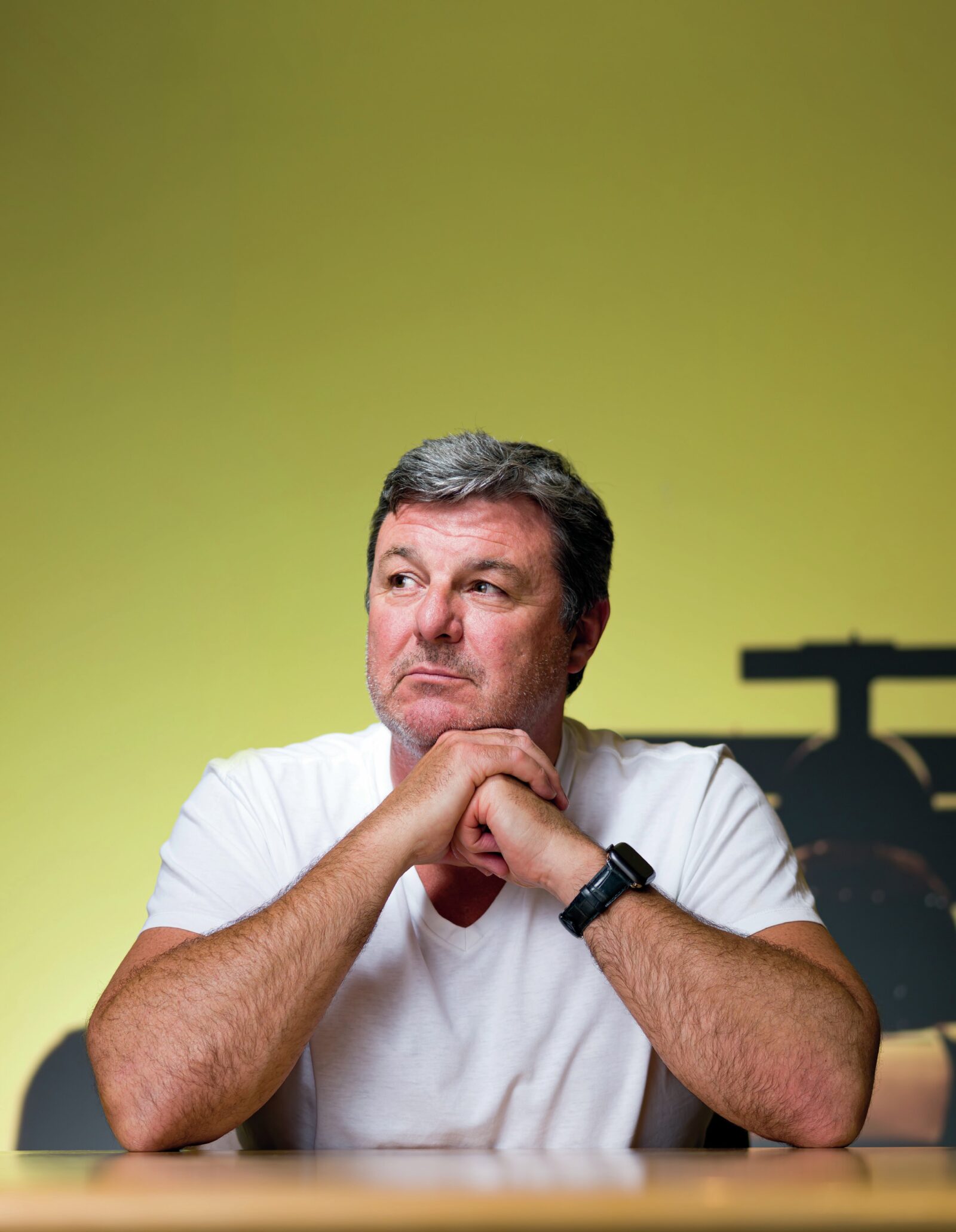
It’s quite common for sports stars to bolt to a tax haven as soon as fame or fortune strike, but convention has seldom been the Mark Blundell way.
“I did think about it,” he says, “but the idea of bringing the kids up in Monaco or somewhere, away from most of the family… It wasn’t for me.”
Appropriately, then, when we meet to discuss a career that embraced a Le Mans 24 Hours victory, grand prix podium finishes and some notable Champ Car successes, we do so at the head office of MB Partners, his sports marketing and management agency in Royston, the Hertfordshire town he has considered his home since childhood.
It is 38 years since Blundell burst onto the motor racing scene as an unknown novice with zero karting experience and a spectacular line in car control, and little more than one since he formally announced his official retirement – though he had raced only intermittently for the best part of two decades, while developing his agency, and continues to compete in historic events for a bit of fun.
His office reflects the Blundell ethos – practical and uncluttered, with a few bits of racing memorabilia neatly aligned. “I have lots more in storage,” he says, tucking in to a plate of sushi, “but I’m never sure why we all keep so much stuff.”
They are fragments from a career he’d never thought possible.
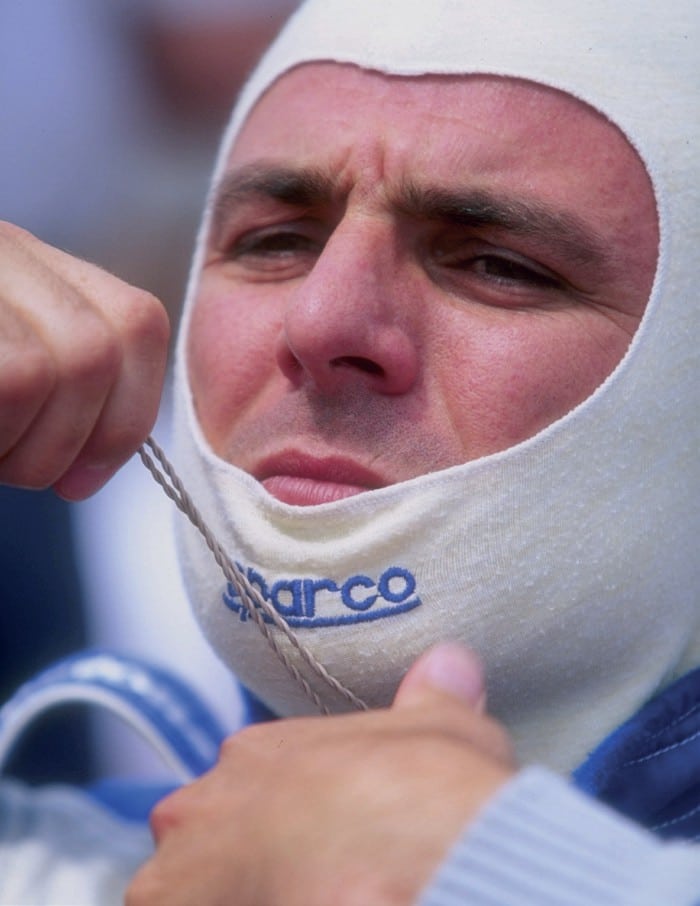
Unlike many drivers, Mark Blundell had no karting past to draw from
Motor Sport: The modern trend is for former grand prix drivers to become media pundits. You’ve done some of that, but seem to have found your niche on the commercial side. How did that start?
MB: “It began [in 2004] when Martin Brundle and I were on the board at the British Racing Drivers’ Club, which at the time was quite flush with funds and allocated some of it to young drivers to support their careers. That was great, but there was nobody helping to make sure the money was spent wisely, to give them guidance, so we set up 2MB.
“Martin’s TV career flourished as the years rolled on and he eventually decided to concentrate on that, so I bought out his share of the business and 2MB became MB Partners. We run various events, bringing companies together to create business opportunities, and currently have 10 drivers on our books [including Mike Conway, Le Mans winner in 2021 and twice an endurance racing world champion].”
Motor racing is at the heart of what you do, but you have dabbled with other sports…
MB: “Yes. We had a few footballers on our books at one point, but our chairman [retail entrepreneur Theo Paphitis, also a keen historic racer] told me I’d never make any money from football – and he was right. The problem is that we’re too transparent – I see everything in black and white while football had too many shades of grey, which is not how I operate.
“We tried golf, too, and within five years were looking after two of the world’s top 125 PGA-ranked players. We’d done some great commercial deals and I’d like to think we were making a good name for ourselves, but regretfully our account manager decided to take our two biggest names to a mainstream US agency and kind of dismantled our golf division overnight.
“I wouldn’t rule out trying other things in future – and we are now doing some digital marketing, for which we have a non-motor sport client – but at that point I said, ‘Right, we’re going back to basics – let’s deal with a sport we understand and know, where we’ve got our network.’”
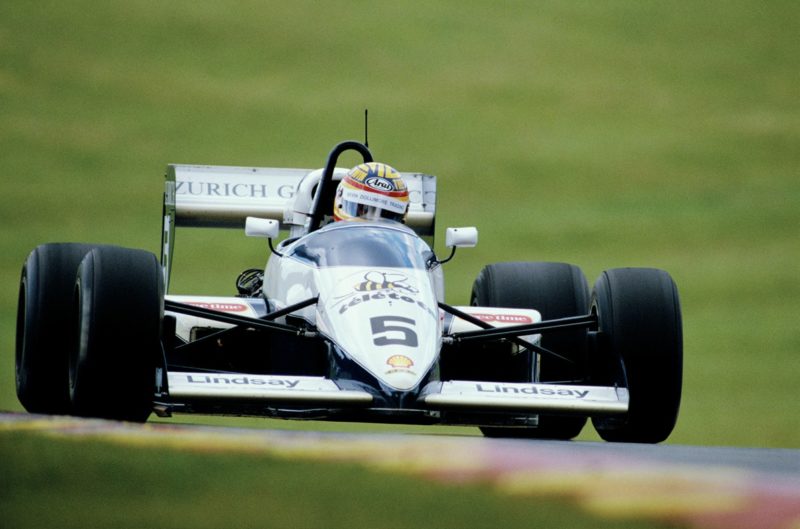
Stellar F3000 form in a privately run car earned Blundell a shot with the works Lola team in ’88
Let’s get back to your own competitive roots. I witnessed your debut at Silverstone in March 1984, driving an FF1600 Lola in a Formula Libre race at a really low-key clubbie, and still have vivid recollections of the increasingly lurid angles you were achieving. You never had the massive accident that looked inevitable. But it was impressive driving from a kid who had no karting background…
MB: “No, but I had ridden successfully in motocross for several years – and that requires balance. People don’t take on board how important that is inside a racing car. You need to feel comfortable.
“Moto cross taught me a huge amount. You saw that in the wet“
“Motocross taught me a huge amount, especially about learning to look for the right line, to see where there might be an extra bit of grip on the track – the lines on a motocross track change by the lap because they are always being churned up. The same thought processes applied when I switched to cars – and I think you saw that in the wet, when my lines tended to differ from everybody else’s.”
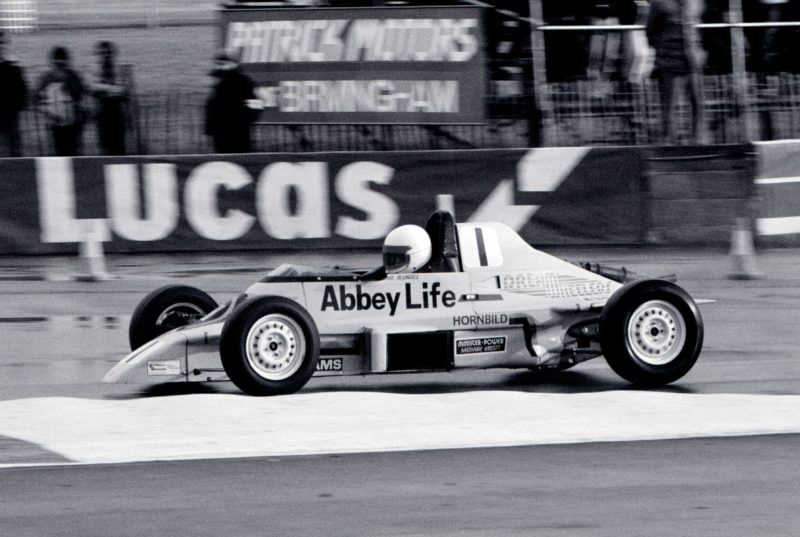
Blundell was one of the FF1600 stars of 1985, racing in a Van Diemen RF85
You’ve always maintained that the racing you did in your early days in FF1600 was the most enjoyable of your whole career…
MB: “Absolutely – and I’m not sure there has ever been quite such a strong group racing in the same junior category at the same time.
If you look at what the class of 1985 achieved as a collective, Damon Hill became world champion, Johnny Herbert won a few grands prix, he and Bertrand Gachot both won Le Mans, I scored podium finishes in Formula 1, won Le Mans and a few Champ Car races and there were several other really quick people up there, too.
“It was a great place to hone your racecraft – and that for me is a bit of an issue in terms of modern motor sport. Where else in sport do you get to an elite level and then not have to use some of the skill sets you learned on the way up? At the moment in grand prix racing, you press a button, activate the DRS, gain 12mph – and past your opponent you go.”
You won the BRDC FF1600 title in 1985 and became European FF2000 champion the following season. So far, so conventional… but then you bypassed F3 and graduated directly to F3000. What was that all about?
MB: “Money! We didn’t have the means to secure a drive with a top F3 team, such as West Surrey, and there was nothing to prove by staying in FF2000, so I started looking at alternative ideas. Stepping up to an even bigger car and learning as much as possible seemed feasible. I borrowed £200,000 and we put the family team back together, running on a very small budget with a secondhand Lola that still had mechanical fuel injection while every other team was running electronic. Was it a smart decision? I don’t know, but at the time it seemed like the only one I could take – and there was nobody to guide me. My dad had car experience – he could tell you how much your Ford Cortina was worth, but he had no relevant motor sport knowledge. It was completely out of his comfort zone.”
“I had zero chance of doing anything with the Brabham“
You led the third race of the year, at Spa, and eventually finished second, which didn’t do you any harm.
MB: “It gave me a huge amount of experience, put me into an international arena and I think gave people some understanding about this kid who was doing things a bit differently. I did eventually make my British F3 debut in the middle of that year, because the TOM’S team asked me to do a few races, but the main reason for accepting was that they paid me, so I had some funds that I could reinvest in F3000.”
You spent the following two seasons in F3000, scoring a few podium finishes for the works Lola team before your results dropped away when racing with Middle bridge in 1989. You were third in the opening race at Silverstone and scored points whenever you finished, but that happened only four times. Were you starting to worry that your career might be losing impetus?
MB: “There were positives and negatives. I accepted the Middle bridge drive because it was free, plus team manager John Macdonald knew Frank Williams, and recommended me to him as a test driver.
Full-time roles like that didn’t really exist at the time, but I ended up with a three-year development contract with one of the best F1 teams. At the same time, Nissan’s Group C car had been built by Lola and my connections there put me forward for a drive – that thing about maintaining relationships, again. The Nissan deal was really good, because it taught me about working with a factory team at a high level and collaborating more closely with team-mates, all of which stood me in good stead for the future.”
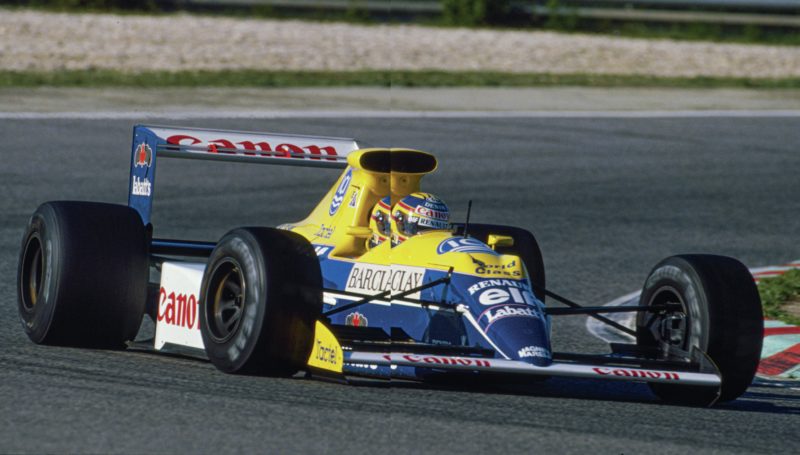
F1 testing at Estoril with Williams in 1990 – but soon Blundell was approached by Brabham to drive for them. It was a dream come true
Your first year at Le Mans was the last before they added chicanes to the Mulsanne Straight. What were your initial impressions?
MB: “I’d driven at low-downforce tracks such as Monza in a single-seater, which floats around, but on the Mulsanne, with all the road cambers and absolutely no wing, the Nissan was simply side-stepping at about 215-220mph. As a young driver I was thinking, ‘How do I analyse this? And am I happy to keep doing it for lap after lap?’
But in reality I had to keep doing it. I’d become a dad at 21, had a young family to feed and was being paid very well.”
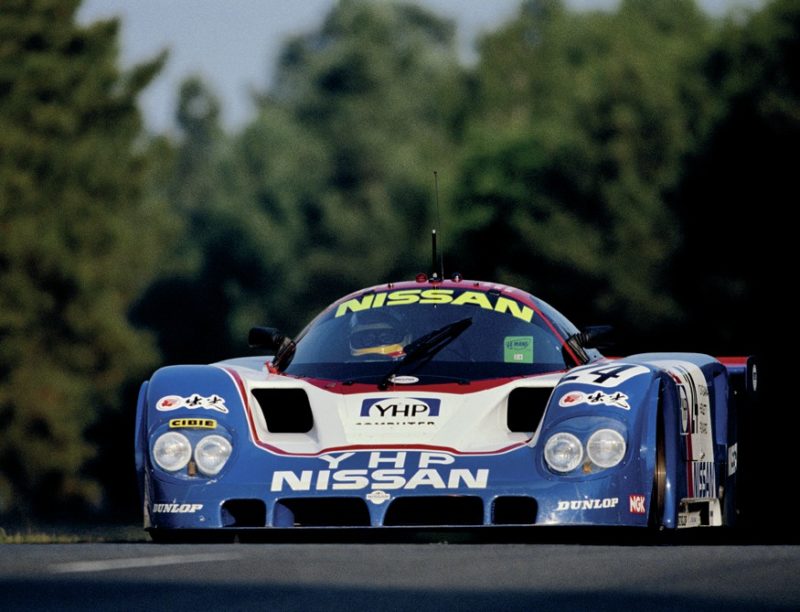
A debut at the Le Mans 24 Hours came with Nissan in 1989 alongside Julian Bailey and Martin Donnelly
In 1990 you combined Williams testing with Nissan race duties, including an epic Le Mans pole lap when you were more than six seconds clear of the rest of the pack – and then Brabham called…
MB: “They did, but initially I’d agreed a deal with Tom Walkinshaw to race for Jaguar in 1991. When the paperwork came through to sign, however, there was a six-figure number missing, a potential bonus in the event of winning the world championship.
I called Tom to discuss it, but Brabham approached while that conversation was going backwards and forwards. ‘Would you like to be a salaried Formula 1 driver?’ I wasn’t going to say no, was I?
“I asked Williams whether they would release me from my contract and they agreed, though their advice was to stay with them and not to accept the Brabham offer – and with hindsight they were absolutely right. But I was still young and more than anything else I wanted to be an F1 driver. I thought all my dreams had come true.

“What I didn’t really appreciate at first was that I had absolutely zero opportunity of doing anything with the Brabham. There was no money – my salary cheques bounced a couple of times! – and reality bit when Williams asked me to stand in for Damon Hill, their new development driver, in a test at Imola just after the San Marino Grand Prix.
I was more than two seconds faster on race tyres in the Williams than I had been on qualifiers in the Brabham.
“I think Damon still owes me a drink, actually, because I phoned him as soon as I knew I was going to Brabham, to suggest that he should pitch for the Williams seat I was vacating…
“I scored a point in Hungary, engine supplier Yamaha’s first in F1, but the whole thing was fairly horrendous from day one.
When I went for a seat fitting, I couldn’t get my knees out from under the front bulkhead quickly enough to vacate the car within the mandatory five seconds. They had to take out the grinder to cut big semi-circles that immediately compromised rigidity. And brake discs kept exploding because they had been skimmed so many times.
“At the end of the season, Jo Ramirez from McLaren came to find me in the Adelaide pits and said Ron Dennis wanted to see me. Ron told me that I wasn’t going to further my career where I was and invited me to become his test driver for ’92 – and at that point it seemed sensible to go back to the drawing board and re-group.
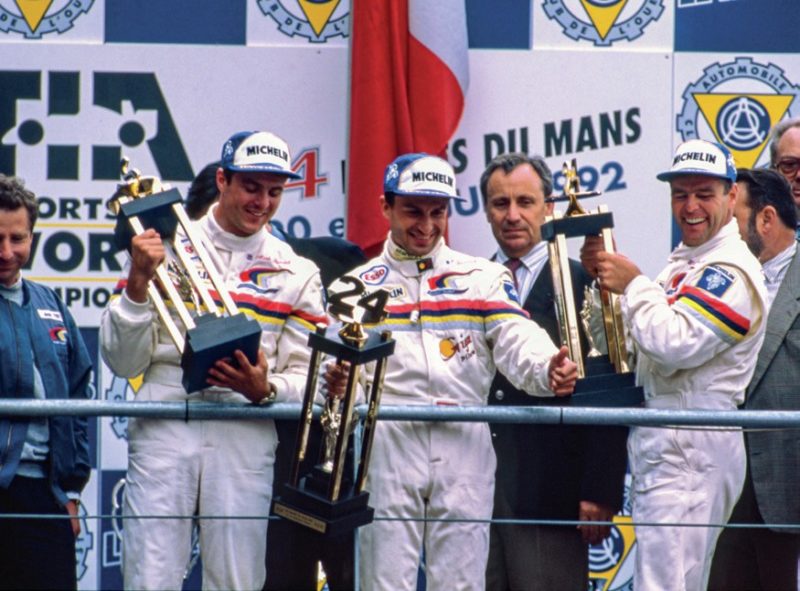
Le Mans in 1992, and a win driving for Peugeot with Yannick Dalmas and Derek Warwick
“Initially I didn’t have any racing scheduled for that season, but Peugeot and McLaren were already talking about a potential future collaboration in Formula 1 and Ron suggested to Jean Todt [then Peugeot’s motor sport chief] that I’d be a suitable candidate for a Le Mans drive. I ended up sharing with Yannick Dalmas and Derek Warwick, and we won.”
Almost 30 years after the event, I still can’t get my head around the fact that Ligier – ateam that had traditionally favoured French or French-speaking drivers – wound up with you and Martin Brundle in 1993.
MB: “I was the first British driver they’d ever signed – and I had some internal support from people at Renault, who knew me from my Williams test days – but it probably wasn’t a good look for a team that was basically funded by the French government.”
I recall reading an interview with Érik Comas, one of the drivers ousted at the end of the previous season, and he was spitting feathers, wondering what the hell the two of you were going to bring to the team. You then finished third first time out in South Africa.
MB: “It wasn’t a bad car, with the Williams- Renault back end, and we delivered by raising the team to a higher level than it had been for a while. I scored two podium finishes, Martin bagged one and it was a nice environment to work in. It just needed a bit more direction internally, but my downfall was not being able to speak French.
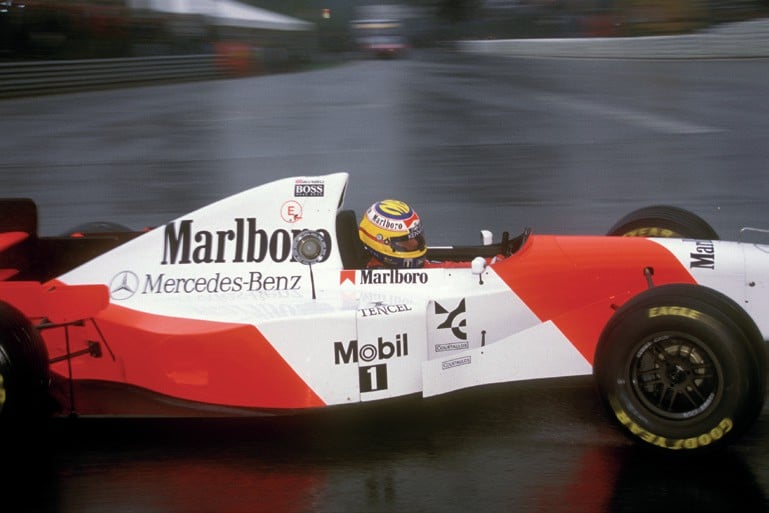
His last F1 season was 1995 with McLaren, here in the wet at Spa
Martin had a reasonable grasp of the language and so I was the one they released at the season’s end.”
At no stage in your Formula 1 career did you ever manage two consecutive seasons with the same team. You spent one season with Tyrrell, then went back to McLaren – initially in a reserve role, though you ended up doing most of the races after Nigel Mansell’s relationship with the team proved brief. Would it have helped if you’d been able to build some continuity?
MB: “Possibly, but you never know. Maybe I have worked in a slightly different way to many drivers, because I was led a lot of the time by trying to make sure I was looking after my young family. Some of my decisionmaking was led by that, as opposed maybe to being a selfish son of a gun, and demanding that I wanted the team to do this or that. That wasn’t me.”
In sharp contrast, when you switched to America’s now-defunct Champ Car series you remained with the same team throughout the five seasons you were there. When did you first start thinking about that as an option?
MB: “Quite late, because initially I thought I’d still be in F1 for 1996. I knew well before the end of my year with McLaren that I wouldn’t be staying, because they’d signed David Coulthard, and had agreed terms with Sauber. But before I’d signed a contract, Red Bull owner Dietrich Mateschitz invested in the team – and one of his conditions was that he wanted first call on the second driver… It had to be a grand prix winner and Johnny [Herbert] was on the market, so…
“My win in the 1997 Fontana 500 was the best of my career“
“I’d got on well with Mercedes in ’95. My engine was always one spec behind Mika Häkkinen’s, about 25bhp down – something I was contractually obliged not to discuss at the time! They’d said that if ever I wanted to go to America they’d provide me with an engine contract, which was worth about $2m at the time.
“When the Sauber deal fell apart, I just felt totally disheartened with F1 and went back to the relationship network I’d built up over the years. Adrian Reynard said he might have an opportunity for me in the
States, told me to jump on a plane and head for PacWest Racing, where we ran Cosworth engines in ’96 and then switched to Mercedes the following season.”
The first year was disrupted by a hefty shunt in Rio, but that 1997 season was pretty good, wasn’t it? Three wins, a couple of other podiums, sixth in the championship, so why did momentum seem to fade after that?

Some of Blundell’s finest performances were in America with PacWest, including three wins in 1997 in the CART series.
MB: “They were good times – and I’d say my win in the 1997 Fontana 500 [at the California Speedway] was probably the best of my career.
I knew what I had to do to make the final few laps work, but I was very nervous that a tyre might let go – especially when we were doing 253mph down the straights and 227mph through the turns. Was it a smart decision at the time? Probably not, but it turned out to be the right one.
“It was just my luck that they increased the prize money to $1m for the following year’s race but in 1997 it was $100,000, split 50/50 between me and PacWest.
“Over the following couple of seasons, the team decided it wanted to expand, running an Indy Lights programme and so on, but we didn’t really have the personnel or the infrastructure to do that. Things gradually stabilised and by 2000 we were starting to look competitive again, to the extent that I led at Fontana before my engine blew.
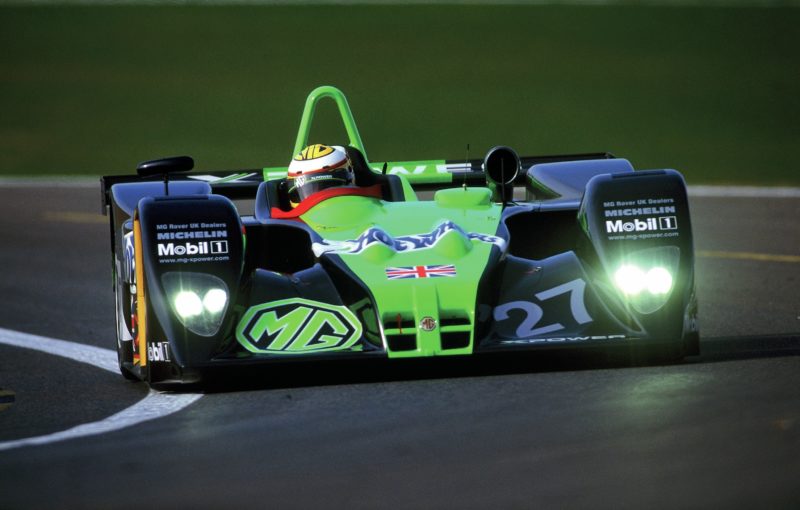
There were two outings for MG at the Le Mans 24 Hours (2001-02) but Blundell failed to finish on both occasions
“I did have opportunities to move to other teams – the sponsor wanted to place me with one of the best outfits, but loyalty means a lot to me and I stayed where I was, even though that ultimately came to kick me in the teeth.
“I’d agreed a new deal for 2001, but had come up with a list of personnel I wanted for specific roles on my car, to give myself the best possible chance for the season ahead. I then turned up for the first test and found nothing was in place, so after that we agreed mutually that we should part and go our separate ways.”
You raced for MG at Le Mans in 2001 and 2002 in the EX257, then Team Bentley in 2003 in the Speed 8 – when you might have challenged the sister car more closely for victory but for a couple of minor glitches – and seemed to drift in and out of racing as you developed your outside business interests. And then, aged 53, you committed to a full season in the British Touring Car Championship. Why?
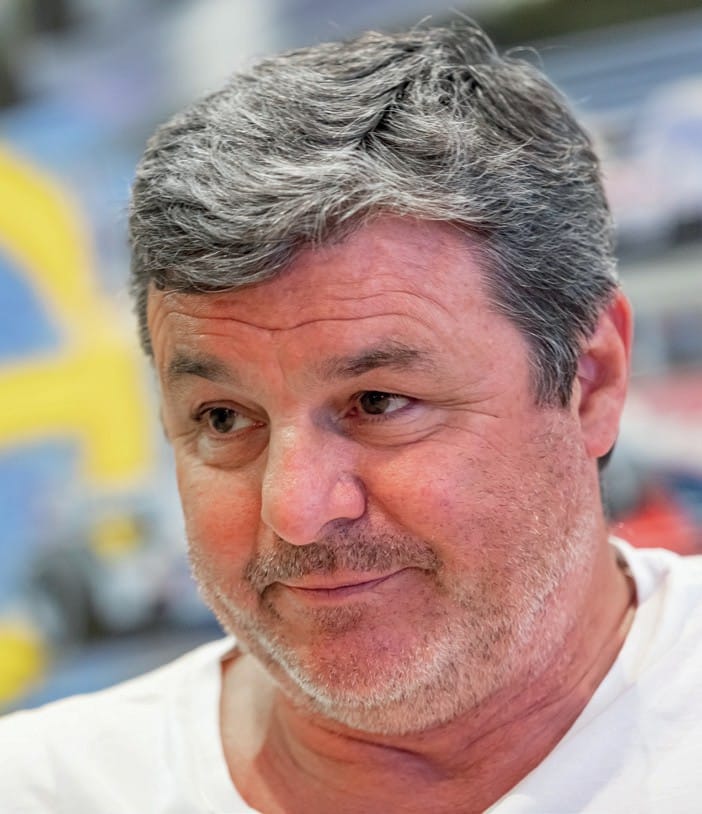
MB: “I had commercial deals in place with [tech companies] HP and Intel, who wanted me to do it, and the initial agreement was that I’d be racing a rear-wheel-drive car, which would have suited me. Unfortunately, for a variety of reasons that didn’t materialise – I ended up in an Audi S3 and my driving style simply didn’t suit the requirements of a front-drive saloon.
“It was fun, but awful in terms of results and probably one of the toughest years in my racing career. I just wish I’d had the chance to see what I might have been able to do with rear-wheel drive.”
But that spawned the MB Motorsport team that has contested the BTCC since 2020 – and is racing this season with the BMW 330e M Sport.
MB: “It did, but we just look after the commercial side of things and let other people deal with the spanners. We’re working this year in partnership with West Surrey Racing, BMW and Jake Hill, whom I rate very highly as a driver. If the chance arises, I might even do a few laps during a test session, just to see.”
Any unfulfilled ambitions?
MB: “I’d like to have done the Indy 500. That was on my original contract for my first year in the States, but then Champ Car and IndyCar split so the race was no longer in our series. I tended to do quite well in the 500-mile races – albeit not in qualifying, because I always set the car up for three hours rather than one lap.
“Overall, I can’t have any complaints. Could I have done a bit better? Perhaps. Does it bother me? No. My inner selfishness probably wasn’t at the required level to make some tough decisions. I think 99% of what I needed was there, but the missing 1% of my arsenal was the nasty bit.”
